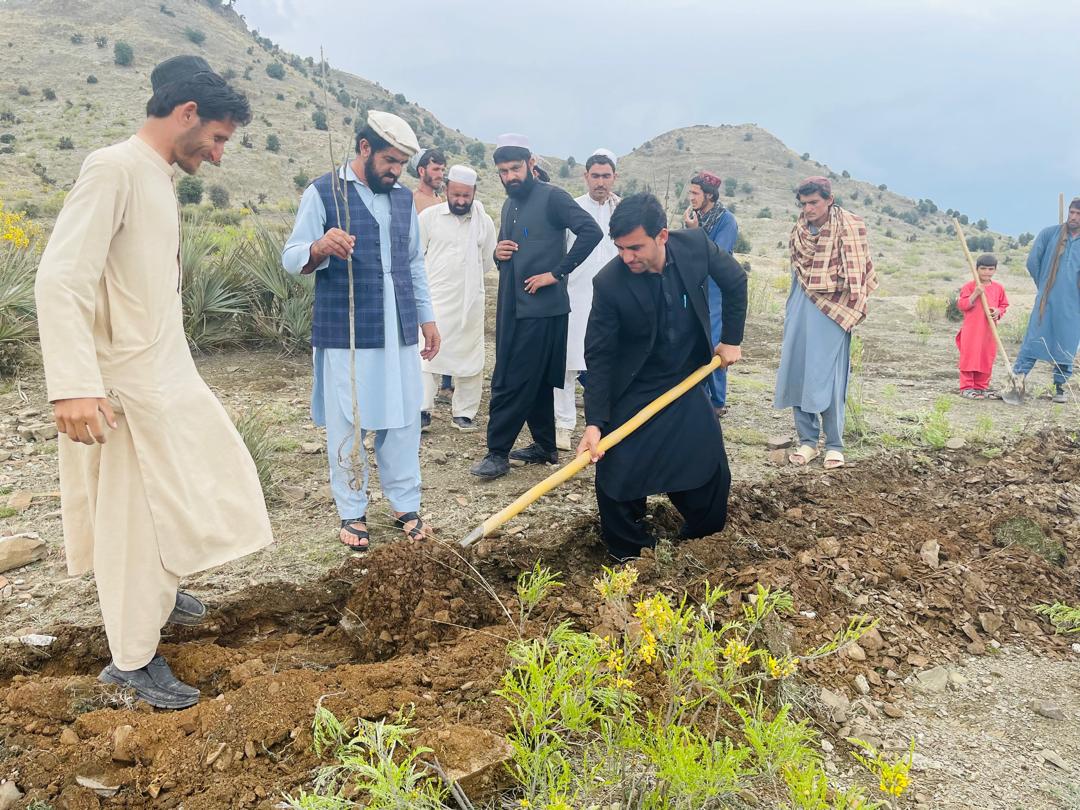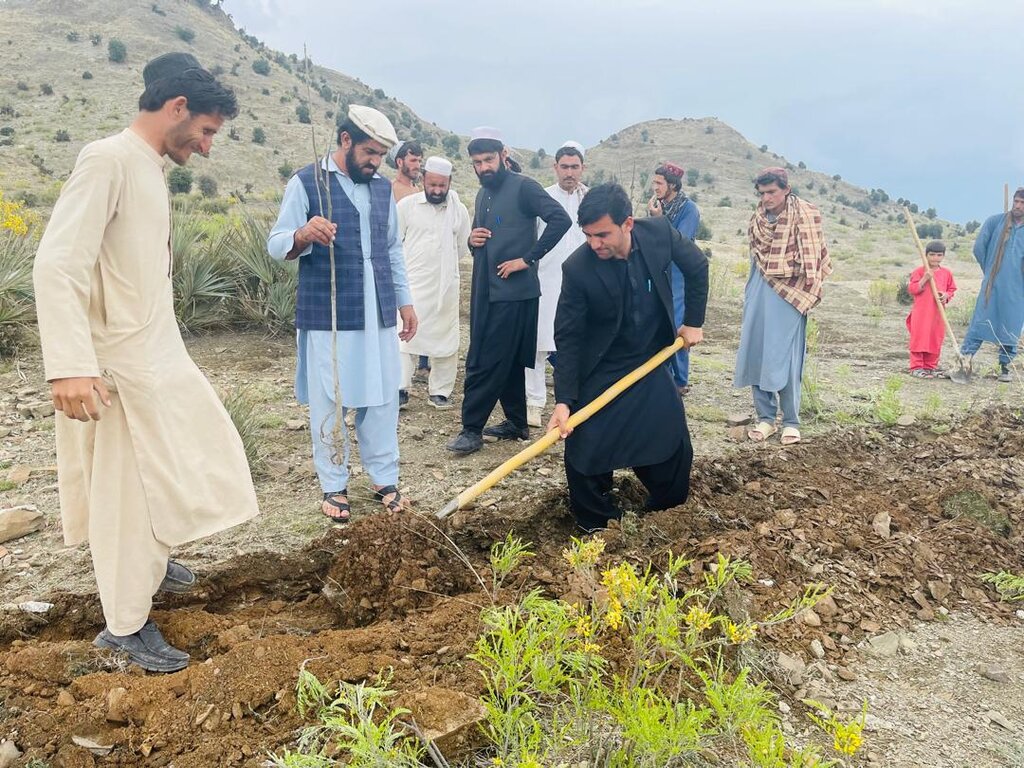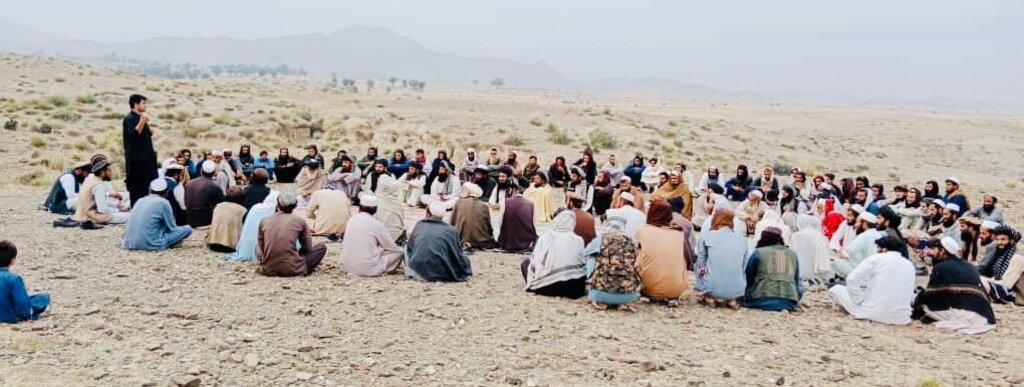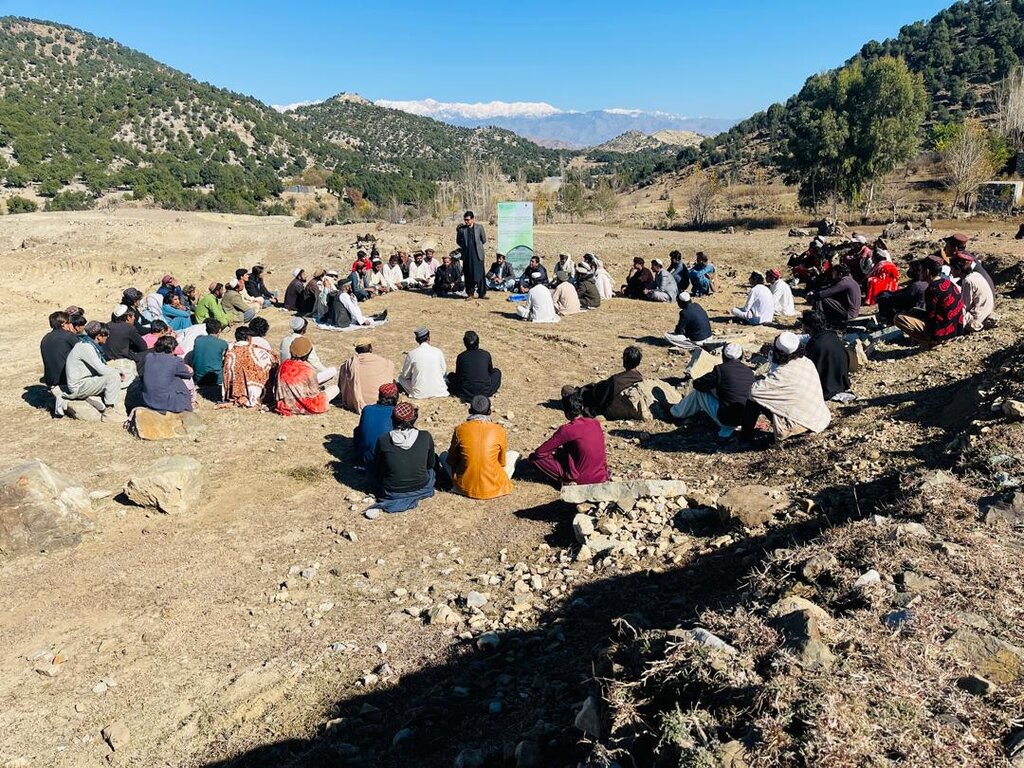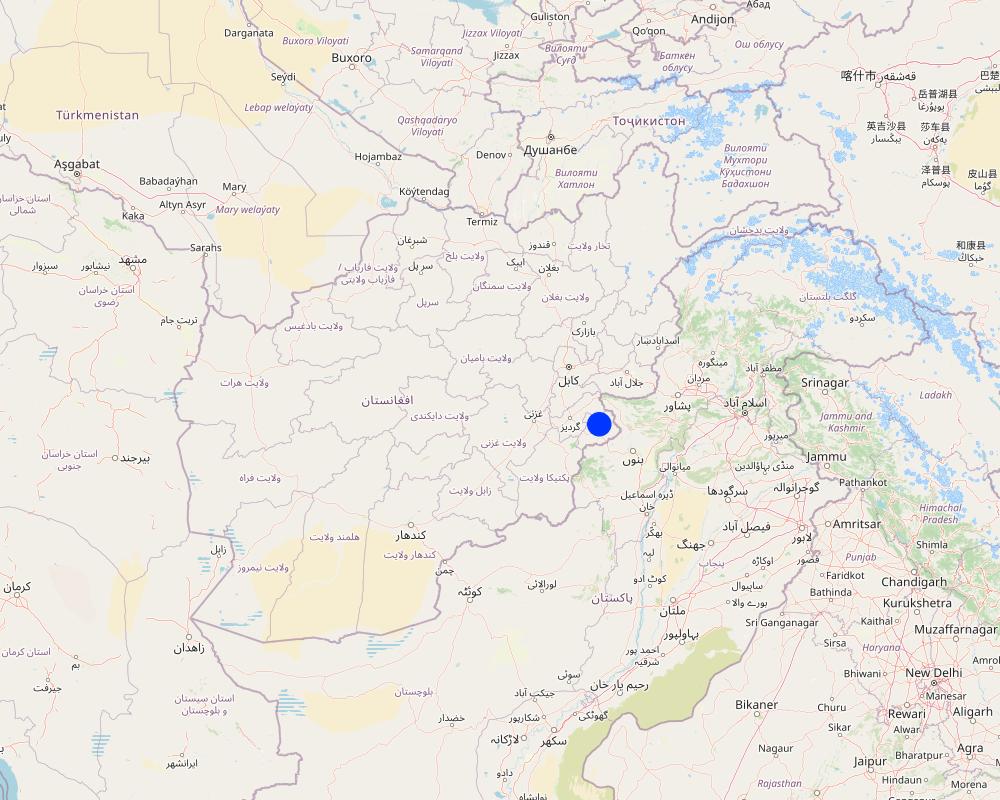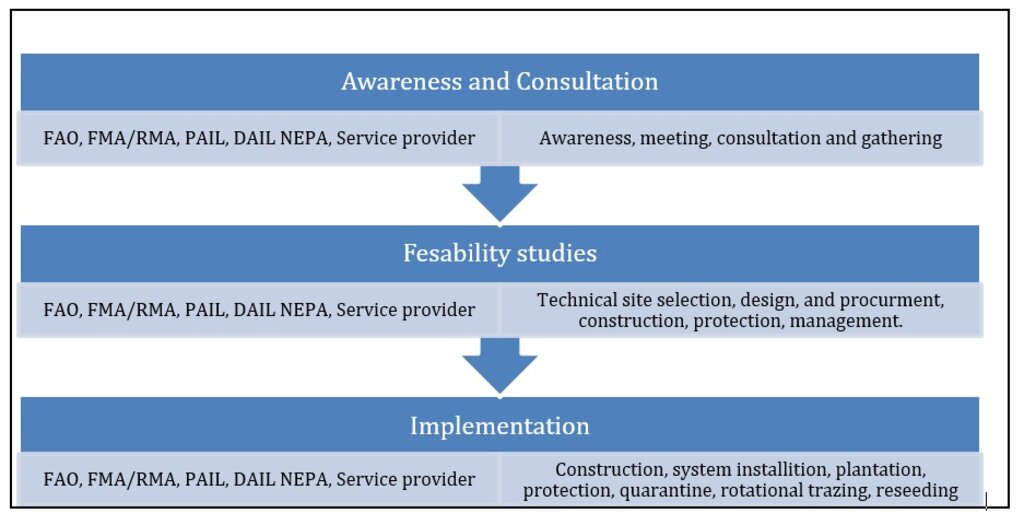Community based reforestation initiatives to restore degraded forest and rangeland [ប្រទេសអាហ្វហ្គានិស្ថាន]
- ការបង្កើត៖
- បច្ចុប្បន្នភាព
- អ្នកចងក្រង៖ Mohammad Aslam Hasand
- អ្នកកែសម្រួល៖ Megha bajaj, Afghanistan Safi, Mohammad Arif
- អ្នកត្រួតពិនិត្យច្រើនទៀត៖ Rima Mekdaschi Studer, Illias Animon, Muhammad Ishaq Safi
د ټولنې پر مټ د بيا رغنيز نوښت له لارې د تخريب شوي ځنګل او څړځای رغول
approaches_7470 - ប្រទេសអាហ្វហ្គានិស្ថាន
- សង្ខេបជា PDF
- សេចក្តីសង្ខេបពេញលេញជាទម្រង់ PDF សម្រាប់បោះពុម្ព
- សេចក្តីសង្ខេបពេញលេញទម្រង់អ៊ីនធឺនេត
- សេចក្តីសង្ខេបពេញលេញ (មិនមានទម្រង់ជាក់លាក់)
- Community based reforestation initiative to restore degraded forest and rangeland.: 6 ខែ មិនា ឆ្នាំ 2025 (inactive)
- Community based reforestation initiative to restore degraded forest and rangeland.: 24 ខែ មិនា ឆ្នាំ 2025 (inactive)
- Community based reforestation initiative to restore degraded forest and rangeland.: 2 ខែ ឧសភា ឆ្នាំ 2025 (inactive)
- Community based reforestation initiatives to restore degraded forest and rangeland: 7 ខែ ឧសភា ឆ្នាំ 2025 (public)
ពិនិត្យមើលគ្រប់ផ្នែក
ពង្រីកមើលទាំងអស់ បង្រួមទាំងអស់1. ព័ត៌មានទូទៅ
1.2 ព័ត៌មានលម្អិតពីបុគ្គលសំខាន់ៗ និងស្ថាប័នដែលចូលរួមក្នុងការវាយតម្លៃ និងចងក្រងឯកសារនៃវិធីសាស្ត្រផ្សព្វផ្សាយ
អ្នកជំនាញឯកទេស SLM:
អ្នកប្រើប្រាស់ដី:
Haleem Bakhtawer Khan
0765983451
bakhtawerkhan.halim@gmail.com
Sapari Forest and Rangeland Management Association
Sapari, Sabari, Khost, Afghanistan
ប្រទេសអាហ្វហ្គានិស្ថាន
ឈ្មោះគម្រោងដែលបានចងក្រងឯកសារ/ វាយតម្លៃលើវិធីសាស្ត្រផ្សព្វផ្សាយ (បើទាក់ទង)
Community-based sustainable land and forest management in Afghanistanឈ្មោះអង្គភាពមួយ (ច្រើន) ដែលបានចងក្រងឯកសារ/ វាយតម្លៃលើវិធីសាស្ត្រផ្សព្វផ្សាយ (បើទាក់ទង)
FAO Afghanistan (FAO Afghanistan) - ប្រទេសអាហ្វហ្គានិស្ថាន1.3 លក្ខខណ្ឌទាក់ទងទៅនឹងការប្រើប្រាស់ទិន្នន័យដែលបានចងក្រងតាមរយៈវ៉ូខេត
តើពេលណាដែលទិន្នន័យបានចងក្រង (នៅទីវាល)?
15/12/2024
អ្នកចងក្រង និង(បុគ្គលសំខាន់ៗ)យល់ព្រមទទួលយកនូវលក្ខខណ្ឌនានាទាក់ទងទៅនឹងការប្រើប្រាស់ទិន្នន័យដែលបានចងក្រងតាមរយៈ វ៉ូខេត:
បាទ/ចា៎
2. ការពណ៌នាអំពីវិធីសាស្ត្រផ្សព្វផ្សាយ SLM
2.1 ពណ៌នាសង្ខេបខ្លីពីវិធីសាស្ត្រផ្សព្វផ្សាយ
Community-driven reforestation initiative that involves awareness-raising, capacity building, feasibility analysis, and collaboration among various stakeholders to address land degradation and promote sustainable forest and rangeland management
2.2 ពណ៌នាលម្អិតពិវិធីសាស្ត្រផ្សព្វផ្សាយ
ពណ៌នាលម្អិតពិវិធីសាស្ត្រផ្សព្វផ្សាយ:
The main aim of this approach is to contribute to ecosystem restoration, biodiversity conservation and carbon sequestration through community awareness-raising, consultation and capacity building, feasibility analysis, site selection as well as resources mobilization for reforestation initiatives in Khost, Afghanistan.
This community driven initiative emerged, bringing together land users, forest and rangeland management associations, environmental experts, specialists and policymakers from various departments like Provincial Agriculture, Irrigation and Livestock, National Environment Projection Agency, District Agriculture, Irrigation and Livestock to heal the land, restore the forests, and rebuild the connection between people and nature.
The first step was to understand the root causes of degradation, followed by a detailed assessment to identify areas most in need of intervention. Priority was given to barren land stripped by erosion, degraded forests areas, and nutrient-depleted soils. The community incorporated traditional ecological knowledge shared by local elders, who recalled periods when the valley supported dense vegetation and thriving ecosystems. This was combined with modern ecological practices to develop a comprehensive restoration plan that balanced traditional knowledge with scientific innovation. The approach ensures awareness raising of the rural community, and knowledge and information enhancement on restoration of degraded forest and rangeland through reforestation initiatives in Khost, Afghanistan.
Specific objectives of the approach are:
1. To enhance the knowledge and awareness of rural communities in Khost, Afghanistan on restoring degraded forests and rangelands, including through public awareness, campaigns, community mobilization, consultations, and feasibility assessments, and mobilizing resources.
2. Involve key stakeholders actively in restoration, including Provincial Agriculture Irrigation and Livestock (PAIL), Provincial National Environmental Protection Agency (NEPA), District Agriculture Irrigation and Livestock department (DAIL), Forest and Rangeland Management Association (FM/RM Association).
3. To enhance the capacity of Forest and Rangeland Management Association (FM/RM Associations) and local communities for effective restoration of degraded forests and rangelands through reforestation initiatives in Khost, Afghanistan.
4. To restore degraded forests and rangelands by enhancing knowledge, skills, and resources for sustainable management. This includes empowering the FM/RM Associations by improving its members’ understanding, skills, capacity, and active participation in conservation and restoration efforts.
5. To restore habitat for strengthening biodiversity conservation.
2.3 រូបភាពនៃវិធីសាស្ត្រផ្សព្វផ្សាយ
កំណត់សំគាល់ទូទៅរបស់រូបថត:
Public awareness and community mobilization – engaging local communities, tribal elders, and stakeholders in decision-making, social participation as well as capacity building – training communities on sustainable practices and policy enforcement.
2.5 ប្រទេស/តំបន់/ទីតាំងកន្លែង ដែលវិធីសាស្ត្រផ្សព្វផ្សាយត្រូវបានអនុវត្តន៍
ប្រទេស:
ប្រទេសអាហ្វហ្គានិស្ថាន
តំបន់/រដ្ឋ/ខេត្ត:
Khost
បញ្ជាក់បន្ថែមពីលក្ខណៈនៃទីតាំង:
Sapari forest, Sabari district, Khost, Afghanistan
Map
×2.6 កាលបរិច្ឆេទនៃការចាប់ផ្តើម និងបញ្ចប់នៃវិធីសាស្រ្តផ្សព្វផ្សាយនេះ
សូមបញ្ជាក់ឆ្នាំដែលបានបង្កើតឡើង:
2023
ឆ្នាំបញ្ចប់ (ប្រសិនបើវិធីសាស្ត្រផ្សព្វផ្សាយត្រូវបានឈប់ប្រើប្រាស់):
2026
2.7 ប្រភេទនៃវិធីសាស្ត្រផ្សព្វផ្សាយ
- ផ្អែកលើគម្រោង/កម្មវិធី
2.8 គោលបំណង/ទិសដៅសំខាន់នៃវិធីសាស្ត្រផ្សព្វផ្សាយ
To enhance the capacity of FM/RM Associations and local communities for adopting the technology on restoration of degraded forests and rangelands through reforestation initiatives in Khost.
-To restore habitat for strengthening biodiversity conservation.
-To promote the conversion of unproductive lands to productive lands.
-To empower local communities to replicate and scale up similar initiatives.
2.9 លក្ខខណ្ឌអនុញ្ញាត ឬរារាំងការអនុវត្តន៍បច្ចេកទេសដែលស្ថិតនៅក្រោមវិធីសាស្រ្តផ្សព្វផ្សាយ
សង្គម/វប្បធម៌/ និងតម្លៃនៃសាសនា
- អំណោយផល
Social gathering, social participation for sapling plantation, information sharing among community members.
ភាពអាចរកបាននៃធនធានហិរញ្ញវត្ថុ និងសេវាកម្ម
- អំណោយផល
There is availability and access to financial resource and services, because all the financial support is directly transferred to community.
បរិបទនៃស្ថាប័ន
- អំណោយផល
FM/RM Associations are established to improve forest and rangeland management.
ការសហការ/ការសម្របសម្រួលតួអង្គពាក់ព័ន្ធ
- អំណោយផល
Other projects are collaborating with FM/RM Associations due to their status as a legal entity
ក្របខណ្ឌច្បាប់ (សិទ្ធិកាន់កាប់ដីធ្លី កម្មសិទ្ធីប្រើប្រាស់ដីនិងទឹក)
- រារាំង
The legal framework for land tenure and land and water use rights exists; they are, however, not properly implemented.
ចំណេះដឹងស្តីពី SLM និងការទទួលបានការគាំទ្រផ្នែកបច្ចេកទេស
- អំណោយផល
Community members have access to SLM knowledge through awareness raising, training and workshops offered
ទំហំការងារ ភាពអាចរកបាននៃកម្លាំងពលកម្ម
- អំណោយផល
Workload of FM/RM Associations during plantation campaign, protection and general management.
3. ការចូលរួម និងតួនាទីរបស់ភាគីពាក់ព័ន្ធ
3.1 អ្នកពាក់ព័ន្ធដែលបានចូលរួមក្នុងវិធីសាស្ត្រផ្សព្វផ្សាយ និងតួនាទីរបស់ពួកគេ
- អ្នកប្រើប្រាស់ដីក្នុងតំបន់/សហគមន៍
Local community and farmers
Land users, local community members: Mobilizations, awareness, social participation as well as self-contribution.
- អង្គការសហគមន៍មូលដ្ឋាន
Forest and Rangeland Management Associations (FM/RM Associations)
FM/RM Associations: decision making, awareness, mobilization, capacity building and social structure for self and in kind contribution.
- អ្នកឯកទេសគ្រប់គ្រងដីប្រកបដោយចីរភាព/ទីប្រឹក្សាបច្ចេកទេសកសិកម្ម
FAO specialist
Technical assistance
- វិស័យឯកជន
Construction company
Construction, mechanical work and installation of system in including facilitation
- រដ្ឋាភិបាលថ្នាក់មូលដ្ឋាន
Provincial Agriculture and Livestock (PAIL), District Agriculture Irrigation and Livestock (DAIL), National Environment Protection Agency (NEPA)
Facilitation for the implementation of project
- អង្គការអន្តរជាតិ
FAO (Food and Agriculture Organization of the United Nations)
Implementation of the GEF-funded project and technical assistance
ប្រសិនមានភាគីពាក់ព័ន្ធច្រើនចូលរួមសូមចង្អុលបង្ហាញភ្នាក់ងារដែលនាំមុខគេ:
UNFAO (Food and Agriculture Organization of the United Nations)
3.2 ការចូលរួមរបស់អ្នកប្រើប្រាស់ដីក្នុងតំបន់/ សហគមន៍ក្នុងតំបន់ក្នុងដំណាក់កាលផ្សេងគ្នានៃវិធីសាស្រ្តផ្សព្វផ្សាយ
| ការចូលរួមរបស់អ្នកប្រើប្រាស់ដីក្នុងតំបន់/សហគមន៍ក្នុងតំបន់ | សូមបញ្ជាក់នរណាត្រូវបានចូលរួម ព្រមទាំងពណ៌នាសកម្មភាពទាំងនោះ | |
|---|---|---|
| ការចាប់ផ្តើម/ការលើកទឹកចិត្ត | គំនិតផ្តួចផ្តើមដោយខ្ឡួនឯង | FM/RM Association: mobilization, awareness raising and general management through social participation. |
| ការរៀបចំផែនការ | អន្តរកម្ម | FM/RM Association: jointly with community by developing of Community Based Natural Resources Management (CBNRM) plan. |
| ការអនុវត្តន៍ | អន្តរកម្ម | FM/RM Association: jointly with community provided labour, facilitation, coordination and consultation as well as supporting all the activities during implementation period as self and community in kind contribution. |
| ការត្រួតពិនិត្យ និងវាយតម្លៃ | អន្តរកម្ម | FM/RM Association: members are key stakeholders of the participatory monitoring and evaluation process. |
3.3 គំនូសបំព្រួញ (ប្រសិនបើមាន)
ការពណ៌នា:
"The Restoration of Degraded Forest and Rangeland Approach" focuses on reviving degraded forest, rangeland and generally ecosystems through sustainable reforestation initiatives. This approach involves: Identifying degraded areas and developing restoration initiatives, involving local communities in decision-making and capacity-building, planting native species, improving soil health, and adopting sustainable land management techniques, regularly assessing progress, addressing challenges, and ensuring long-term sustainability.
This integrated approach helps restore forest and rangeland, biodiversity, improve water retention, prevent soil erosion, and enhance local livelihoods.
Acronyms and Key Concepts:
Food and Agriculture Organization of the United Nations (FAO)
Provincial Agriculture, Irrigation and Livestock (PAIL)
District Agriculture, Irrigation and Livestock (DAIL)
Forest and Rangeland Management Association (FM/RM Association)
Service providers are referred to different construction and logistics’ companies and contractors.
អ្នកនិពន្ធ:
Mohammad Aslam Hasand
3.4 ការសម្រេចចិត្តលើការជ្រើសរើសបច្ចេកទេស SLM
សូមបញ្ជាក់តើអ្នកណាជាអ្នកបានសម្រេចចិត្តក្នុងការជ្រើសរើសបច្ចេកទេសដើម្បីយកមកអនុវត្តន៍:
- គ្រប់ភាគីពាក់ព័ន្ធទាំងអស់ដែលជាផ្នែកនៃវិធីសាស្រ្តផ្សព្វផ្សាយដោយមានការចូលរួម
ចូរពន្យល់:
It was a participatory feasibility study that involved joint decision making
សូមបញ្ជាក់ តើការសម្រេចធ្វើឡើងដោយផ្អែកលើអ្វីជាមូលដ្ឋាន:
- វាយតម្លៃទៅលើចំណេះដឹងស្តីអំពី SLM ដែលបានចងក្រងជាឯកសារបានត្រឹមត្រូវ (ផ្អែកលើភស្តុតាងជាមូលដ្ឋានដើម្បីសម្រេចចិត្ត)
4. ជំនួយបច្ចេកទេស ការកសាងសមត្ថភាព និងការគ្រប់គ្រងចំណេះដឹង
4.1 ការកសាងសមត្ថភាព/ បណ្តុះបណ្តាល
តើវគ្គបណ្តុះបណ្តាលបានផ្តល់ឱ្យអ្នកប្រើប្រាស់ដី/អ្នកពាក់ព័ន្ធផ្សេងៗទៀតដែរឬទេ?
បាទ/ចា៎
សូមបញ្ជាក់តើអ្នកណាត្រូវបានបណ្តុះបណ្តាល:
- អ្នកប្រើប្រាស់ដី
- បុគ្គលិកចុះទីវាល/អ្នកផ្តល់ប្រឹក្សាយោបល់
ទម្រង់នៃការបណ្តុះបណ្តាល:
- អនុវត្តន៍ជាមួយការងារ
- ពីកសិករទីកសិករ
- ការប្រជុំជាសាធារណៈ
ប្រធានបទបណ្តុះបណ្តាល:
SLM/SFM practices, awareness, mobilization, quarantine, rotational grazing, biodiversity conservation, climate change, CBNRM plan, participatory moinotoring, operation of the system and general management of natural resources.
4.2 សេវាផ្តល់ប្រឹក្សាយោបល់
តើអ្នកប្រើប្រាស់ដីបានទទួលនូវសេវាផ្តល់ប្រឹក្សាដែរ ឬទេ?
បាទ/ចា៎
សូមបញ្ជាក់ប្រសិនបើសេវាកម្មប្រឹក្សាយោបល់ត្រូវបានផ្តល់ឱ្យ:
- នៅលើដីរបស់អ្នកប្រើប្រាស់ដី
ពណ៌នា/ពន្យល់:
Operating the irrigation system, sapling transplantation, quarantine, rotational grazing and general management.
4.3 ការពង្រឹងសមត្ថភាពស្ថាប័ន (ការអភិរឌ្ឍន៍អង្គភាព)
តើស្ថាប័នទាំងអស់ត្រូវបានបង្កើតឡើង ឬពង្រឹងសមត្ថភាពតាមរយៈវិធីសាស្ត្រផ្សព្វផ្សាយដែរ ឬទេ?
- បាទ/ច៎ា ជាមធ្យម
សូមបញ្ជាក់ថាតើស្ថាប័នត្រូវបានពង្រឹង ឬបង្កើតឡើងនៅត្រឹមកម្រិតណា(ច្រើន)?
- ថ្នាក់មូលដ្ឋាន
ចូពណ៌នាពីស្ថាប័ន តួនាទី និងទំនួលខុសត្រូវ សមាជិក ។ល។:
FM/RM Association
សូមបញ្ជាក់ប្រភេទនៃការគាំទ្រ:
- ហិរញ្ញវត្ថុ
- ការកសាងសមត្ថភាព/ បណ្តុះបណ្តាល
- សម្ភារៈ
សូមផ្តល់ព័ត៌មានបន្ថែមទៀតឱ្យបានលម្អិត:
Signed LoA for implementation and cost contribution, on site awareness raising, social mobilization, holding gathering and workshops and provided construction materials and tools for nursery establishment.
4.4 ការត្រួតពិនិត្យ និងវាយតម្លៃ
តើការត្រួតពិនិត្យ និងវាយតម្លៃគឺជាផ្នែកមួយនៃវិធីសាស្ត្រដែរឬទេ?
បាទ/ចា៎
មតិយោបល់:
FM/RM Association has the responsibility to perform monitoring of all activities in Sapari forest of Sabari district of Khost province.
ប្រសិន បាទ/ច៎ា តើឯកសារនេះបានបង្កើតឡើងក្នុងគោលបំណងប្រើប្រាស់សម្រាប់ការត្រួតពិនិត្យ និងវាយតម្លៃដែរឬទេ?
បាទ/ចា៎
មតិយោបល់:
Monitoring is a part of the Community-based NRM plan.
4.5 ការស្រាវជ្រាវ
តើការស្រាវជ្រាវ គឺជាផ្នែកមួយនៃវិធីសាស្រ្តដែរឬទេ?
ទេ
5. ថវិកា និងសម្ភារៈឧបត្ថម្ភពីខាងក្រៅ
5.1 ថវិកាប្រចាំឆ្នាំសម្រាប់ផ្សព្វផ្សាយ SLM
ប្រសិនបើចំនួនពិតប្រាកដនៃថវិកាប្រចាំឆ្នាំមិនត្រូវបានដឹងច្បាស់ សូមប្រាប់ពីចន្លោះនៃថវិកានោះ:
- 10,000-100,000
មតិយោបល់ (ឧ. ប្រភពសំខាន់នៃមូលនិធិ/ម្ចាស់ជំនួយចំបង):
Financial support is provided by the FAO-GEF project and in-kind contributions are from the community. In-kind contribution covers providing physical space or facilities to support the project, coordination, consultation and general facilitation, and human resources for restoration, patrolling, quarantine, and other community relevant activities. Hence, 80 percent of the financial support is provided by the FAO-GEF project and 20 percent by the community (as in-kind support).
5.2 ការគាំទ្រផ្នែកហិរញ្ញវត្ថុ / សម្ភារៈដែលបានផ្តល់ទៅឱ្យអ្នកប្រើប្រាស់ដី
តើអ្នកប្រើប្រាស់ដីបានទទួលការគាំទ្រផ្នែកហិរញ្ញវត្ថ/សម្ភារៈសម្រាប់ការអនុវត្តន៍បច្ចេកទេសដែរឬទេ:
បាទ/ចា៎
ប្រសិនបាទ/ច៎ា សូមបញ្ជាក់ប្រភេទ(ច្រើន)នៃការគាំទ្រ លក្ខខណ្ឌ និងអ្នកផ្តល់ឱ្យ(ច្រើន):
Technical support and livelihood packages including solar cooker, chopper machine, dairy toolkit, walnut cracker, construction material for reservoirs (cement, sand, stone, pipes), material for nursery establishment and saplings were provided.
5.3 សូមបញ្ជាក់ពីធាតុចូលត្រូវបានផ្តល់បដិភាគ (រួមទាំងកម្លាំងពលកម្ម)
- គ្មាន
ប្រសិនបើកម្លាំងពលកម្មធ្វើដោយអ្នកប្រើប្រាស់ដី តើវាជាធាតុចូលដ៏សំខាន់មួយដែរ ឬទេ:
- ដោយស្ម័គ្រចិត្ត
5.4 ឥណទាន
តើឥណទានដែលបានផ្តល់នៅក្រោមវិធីសាស្ត្រផ្សព្វផ្សាយសម្រាប់សកម្មភាព SLM នេះយ៉ាងដូចម្តេច?
ទេ
5.5 ការលើកទឹកចិត្ត ឬវិធីសាស្ត្រដ៏ទៃទៀត
តើមានការលើកទឹកចិត្តផ្សេងទៀត ឬឧបករណ៍ប្រើប្រាស់ដើម្បីលើកកម្ពស់ការអនុវត្តន៍បច្ចេកទេស SLM?
បាទ/ចា៎
បើបាទ/ចា៎ សូមបញ្ជាក់:
Training workshops and other capacity building programmes, field day tour, social gathering as well as site visits by communities.
6. ការវិភាគរកផលប៉ះពាល់ និងសេចក្តីសន្និដ្ឋាន
6.1 ផលប៉ះពាល់នៃវិធីសាស្ត្រផ្សព្វផ្សាយ
តើវិធីសាស្ត្រផ្សព្វផ្សាយបានផ្តល់សិទ្ធិអំណាចដល់អ្នកប្រើប្រាស់ដី ធ្វើឱ្យប្រសើរឡើងនូវការចួលរួមអ្នកពាក់ព័ន្ធ?
- ទេ
- បាទ/ច៎ា បន្តិចបន្តួច
- បាទ/ច៎ា ជាមធ្យម
- បាទ/ច៎ា បានខ្លាំង
Capacity building, empowering of Forest and rangeland management associations (FM/RM Associations)
តើវិធីសាស្រ្តផ្សព្វផ្សាយនេះអនុញ្ញាតឱ្យធ្វើការសម្រេចចិត្ដដោយផ្អែកលើភស្តុតាងជាមូលដ្ឋានដែរ ឬទេ?
- ទេ
- បាទ/ច៎ា បន្តិចបន្តួច
- បាទ/ច៎ា ជាមធ្យម
- បាទ/ច៎ា បានខ្លាំង
Monitoring and participatory assessment skills were improved under the approach allowing to assess results and impacts and collecting evidence for decision-making
តើវិធីសាស្ត្រផ្សព្វផ្សាយជួយអ្នកប្រើប្រាស់ដីដើម្បីអនុវត្តន៍ និងថែទាំបច្ចេកទេស SLM?
- ទេ
- បាទ/ច៎ា បន្តិចបន្តួច
- បាទ/ច៎ា ជាមធ្យម
- បាទ/ច៎ា បានខ្លាំង
Consultation meetings, workshops, training, on job practical work and capacity building for better implementation of the technology.
តើវិធីសាស្រ្តផ្សព្វផ្សាយនេះធ្វើឱ្យប្រសើរឡើងនូវការសម្របសម្រួលនិងការអនុវត្តចំណាយរបស់ SLMមានប្រសិទ្ធិភាពបែបណា? :
- ទេ
- បាទ/ច៎ា បន្តិចបន្តួច
- បាទ/ច៎ា ជាមធ្យម
- បាទ/ច៎ា បានខ្លាំង
FM/RM Associations and local community contribution, particularly providing of labour during plantation campaigns, protection and maintenance.
តើវិធីសាស្រ្តផ្សព្វផ្សាយនេះប្រមូលផ្តុំ / ធ្វើឱ្យប្រសើរឡើងនូវការទទួលបានធនធានហិរញ្ញវត្ថុសម្រាប់ការអនុវត្ត SLM?
- ទេ
- បាទ/ច៎ា បន្តិចបន្តួច
- បាទ/ច៎ា ជាមធ្យម
- បាទ/ច៎ា បានខ្លាំង
Financial resources accessed according to the terms specified in the LoA.
តើវិធីសាស្ត្រផ្សព្វផ្សាយនេះធ្វើឱ្យចំណេះដឹងប្រសើឡើង និងសមត្ថភាពរបស់អ្នកប្រើប្រាស់ដីក្នុងការអនុវត្តន៏ SLM?
- ទេ
- បាទ/ច៎ា បន្តិចបន្តួច
- បាទ/ច៎ា ជាមធ្យម
- បាទ/ច៎ា បានខ្លាំង
FAO technical staff conducted various trainings, workshop as well as awareness raising session regarding improving of land users’ capacity for better implementation of the SLM.
តើវីធីសាស្ត្រផ្សព្វផ្សាយនេះពង្រឹងចំណេះដឹង និងកសាងសមត្ថភាពរបស់អ្នកពាក់ព័ន្ធឬទេ?
- ទេ
- បាទ/ច៎ា បន្តិចបន្តួច
- បាទ/ច៎ា ជាមធ្យម
- បាទ/ច៎ា បានខ្លាំង
Local governmental institutions like provicial and district Agriculture, Irrigation and Livestock (PAIL/DAIL) departements,FM/RM Associations and local community knowledge has been improved on SLM/SFM.
តើវីធីសាស្ត្រនេះបានជួយកសាង/ពង្រឹងស្ថាប័ន កិច្ចសហប្រតិបត្តិការរវាងអ្នកពាក់ព័ន្ធដែរ ឬទេ?
- ទេ
- បាទ/ច៎ា បន្តិចបន្តួច
- បាទ/ច៎ា ជាមធ្យម
- បាទ/ច៎ា បានខ្លាំង
Collaboration among FM/RM Associations, local community, governmental institutions and other stakeholders has been strengthened.
តើវីធីសាស្ត្រផ្សព្វផ្សាយនេះបានកាត់បន្ថយជំលោះឬទេ?
- ទេ
- បាទ/ច៎ា បន្តិចបន្តួច
- បាទ/ច៎ា ជាមធ្យម
- បាទ/ច៎ា បានខ្លាំង
FM/RM Associations and local community facilitated implementation of the project on communal land as well as mitigated all sort of conflicts regarding protection, quarantine, rotational grazing and other sections.
តើវិធីសាស្ត្រផ្សព្វផ្សាយ បានធ្វើឱ្យប្រសើរឡើងសមភាពយេនឌ័រ និងផ្តល់សិទិ្ធអំណាចដល់ស្ត្រី និងក្មេងស្រី?
- ទេ
- បាទ/ច៎ា បន្តិចបន្តួច
- បាទ/ច៎ា ជាមធ្យម
- បាទ/ច៎ា បានខ្លាំង
Women were actively involved in all project activities; some livelihood programs have been targeted at women and girls.
តើវិធីសាស្ត្រផ្សព្វផ្សាយបានលើកទឹកចិត្តដល់អ្នកប្រើប្រាស់ដីដែលជាយុវជន/ក្មេងជំនាន់ក្រោយឱ្យចូលរួមក្នុង SLM ?
- ទេ
- បាទ/ច៎ា បន្តិចបន្តួច
- បាទ/ច៎ា ជាមធ្យម
- បាទ/ច៎ា បានខ្លាំង
Through awareness raising, workshop, training, farmer field schools, brochures and other visibility materials encouraged young people or next generation to engage in SLM.
Awareness raising sessions, trainings and workshops enhanced the knowledge of Forest and Rangeland Management Association (FMA/RMA) members and local community regarding sustainable of natural resource management.
តើវិធីសាស្ត្របានធ្វើឱ្យប្រសើរឡើងនូវការកសាងសមត្ថភាពរបស់អ្នកប្រើប្រាស់ដីដើម្បីបន្សុំាទៅនឹងការប្រែប្រួលអាកាសធាតុ/អាកាសធាតុក្តៅហែង និងកាត់បន្ថាយគ្រោះមហន្តរាយទាក់ទឹងនឹងអាកាសធាតុ?
- ទេ
- បាទ/ច៎ា បន្តិចបន្តួច
- បាទ/ច៎ា ជាមធ្យម
- បាទ/ច៎ា បានខ្លាំង
Improved water harvesting, controlled land degradation, planted saplings, prevented flood splash and water erosion which improved land users’ resilience to climatic changes/extremes and disaster.
តើវិធីសាស្ត្រផ្សព្វផ្សាយនេះនាំឱ្យមានការងារ ឱកាសរកប្រាក់ចំណូល?
- ទេ
- បាទ/ច៎ា បន្តិចបន្តួច
- បាទ/ច៎ា ជាមធ្យម
- បាទ/ច៎ា បានខ្លាំង
Short employment created for local community.
6.2 ការលើកទឹកចិត្តចម្បងៗរបស់អ្នកប្រើប្រាស់ដីសម្រាប់ការអនុវត្តបច្ចេកទេស SLM
- បង្កើនផលិតកម្ម
Increased production of fodder from trees and grasses.
- ការកាត់បន្ថយការធ្លាក់ចុះគុណភាពដី
Improved soil cover reduces water-induced erosion, helping to preserve soil fertility. Water harvesting captures surface runoff for irrigation and contributes to groundwater recharge.
- កាត់បន្ថយហានិភ័យនៃគ្រោះមហន្តរាយ
- កាត់បន្ថយទំហំការងារ
Through active social participation.
- ច្បាប់ និងបទបញ្ជា (ផាកពិន័យ)/ការប្រតិបត្តិ
Enforcement of customary roles and regulations among the community, enhance tribal and traditional structures for facilitation and implementation of the technology.
- លើកកម្ពស់ចំណេះដឹង និងជំនាញ SLM
The consciousness of local community has been enhanced regarding SLM.
- ការកាត់បន្ថយជម្លោះ
The establishment of FM/RM Associations helped mitigate conflicts and facilitated smoother project implementation.
6.3 សកម្មភាពផ្សព្វផ្សាយដែលប្រកបដោយចីរភាព
តើអ្នកប្រើប្រាស់ដីអាចធ្វើឱ្យមានចីរភាពនូវអ្វីដែលត្រូវបានអនុវត្តន៍តាមរយៈវិធីសាស្ត្រផ្សព្វផ្សាយដែរឬទេ(ដោយពុំមានការគាំទ្រពីអ្នកខាងក្រៅ)?
- បាទ/ចា៎
ប្រសិនបាទ/ច៎ា សូមរៀបរាប់ថាធ្វើយ៉ាងម៉េច:
Land users can sustain these efforts because their capacity has been strengthened, they have a sense of local ownership, and adaptive tribal management systems are in place, ensuring the long-term benefits of restoration for future generations.
6.4 ភាពខ្លាំង/ គុណសម្បត្តិនៃវិធីសាស្ត្រផ្សព្វផ្សាយ
| ភាពខ្លាំង/ គុណសម្បត្តិ/ ឱកាស ទស្សនៈរបស់អ្នកប្រើប្រាស់ដី |
|---|
| Awareness, consciousness and knowledge on natural resources management of communities enhanced through workshops and trainings. |
| Increased availability of natural resources for better livelihoods of communities. |
| With increased community contribution, local efforts will support the protection and sustainable management of resources even after external support ends. |
| ភាពខ្លាំង/ គុណសម្បត្តិ/ ឱកាស ទស្សនៈរបស់បុគ្គលសំខាន់ៗ |
|---|
| This approach revives ecosystems by reintroducing native plant and animal species, supporting increased biodiversity and creating habitats for wildlife. |
| This approach improves ecosystem resilience, supports sustainable livelihoods, and promotes climate change adaptation. Restoration ensures long-term sustainability while addressing environmental, economic, and cultural needs. |
| The established FM/RM Associations have become the recognized legal bodies for managing forests, rangelands, and other natural resources. They will be responsible for ensuring sustainability and long-term protection after the project. |
6.5 ភាពខ្សោយ/ គុណវិបត្តិនៃវិធីសាស្ត្រ និងរកដំណោះស្រាយ
| ភាពខ្សោយ/ គុណវិបត្តិ/ ហានិភ័យ ទស្សនៈរបស់អ្នកប្រើប្រាស់ដី | តើបច្ចេកទេសទាំងនោះបានដោះស្រាយបញ្ហាដូចម្តេច? |
|---|---|
| FM/RM Associations established, but they need to be better organized and recognized. | The Ministry of Agriculture Irrigation and Livestock of Afghanistan may connect and empower these local institutions. |
| Some components of the project were intended for women’s participation; however, due to government restrictions on women's employment, this remains a sensitive issue and can be considered a limitation in project implementation. | Government should consider mainstreaming gender in such projects where gender is a key aspect. |
| This approach has been implemented in faraway forests with little management personnel to enforce law on the ground; unless communities manage these lands well, protection of natural resources could get weak. | Community should take more responsibility for protecting natural resources. |
| ភាពខ្សោយ/ គុណវិបត្តិ/ ហានិភ័យក្នុងទស្សនៈរបស់បុគ្គលសំខាន់ៗ | តើបច្ចេកទេសទាំងនោះបានដោះស្រាយបញ្ហាដូចម្តេច? |
|---|---|
| This approach often requires significant initial investment in terms of funding, materials, labor, and technical expertise. This includes costs for site preparation, planting, irrigation, and ongoing maintenance, which can be limiting for many communities. | Adequate budget and community contribution can overcome or reduce this weakness. |
| This approach can take many years, even decades, to show significant ecological improvements, which can lead to frustration, reduced enthusiasm, or a loss of community and donor support. | Strong mobilization and raising of the ownership sense in the community can overcome this weakness. |
| If local communities are not adequately involved, they may not feel a sense of ownership or responsibility for the project, leading to poor long-term maintenance and protection of the restored areas. | This should be a community-based project, ensuring that, after donor support ends, the community takes responsibility for its ongoing maintenance and sustainability. |
| Insecure land tenure and unclear property rights can lead to conflicts over land use and limit the ability of communities to manage and protect restored areas. | Solving conflict over property rights must be facilitated by the communities themselves; government agencies can empower them on conflict resolution. |
7. ឯកសារយោង និងវេបសាយ
7.1 វិធីសាស្ត្រ/ ប្រភពនៃព័ត៌មាន
- តាមការចុះទីវាល ការស្រាវជ្រាវនៅទីវាល
10
- ការសម្ភាសន៍ជាមួយអ្នកប្រើប្រាស់ដី
40
ការតភ្ជាប់ និងម៉ូឌុល
ពង្រីកមើលទាំងអស់ បង្រួមទាំងអស់ការតភ្ជាប់
គ្មានការតភ្ជាប់
ម៉ូឌុល
គ្មានម៉ូឌុល


